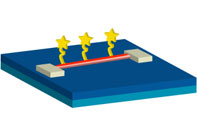Sensors inform about diseases
The foundation stones are laid for a new type of sensor, which in the long term can help doctors to diagnose diseases of the nervous system. It is the long term perspective of Lars Iversen's recently completed PhD project.
Lars has worked at the Bio-Nanotechnology Laboratory at the Nano-Science Center. His project is part of the whole group's objective to design and produce ultra sensitive biosensors based on nanowires. The heart of these sensors consists of an oblong semiconductor crystal with a length of a few micrometers and with a thickness of 100 nanometers - a nanowire. The researchers bind the proteins they are interested in to the nanowires.
There are several research groups around the world that work with nanowire sensors. They have showed that sensors can be used for the detection of cancer markers. What is new with our biosensors is that we are working with proteins from the world of the nervous system - proteins that are involved in a number of neurological diseases and which doctors for that reason would like be able to target with new medicines. With our system that can become easier in the future, explains Lars Iversen.

Skematical drawing of biosensor. The platform is shown in blue, the nanowire in red and the bound proteins in yellow.
The brain communicates via agents called neurotransmitters. With diseases like Alzheimer's, Parkinson's and epilepsy there is an imbalance in the level of neurotransmitters in the brain. The idea with the new biosensors is that in the future researchers can use them to make the diagnosis or test for new drugs. But there is still a long way to go before the new sensors can be put into practice.
The principal of these bio sensors is that the nanowire can detect very precisely what happens at its surface. The nanowires is so small, that even small changes can be sensed. The researchers would like to be able to measure the typical change of charges occurring when a protein on the surface captures a neurotransmitter molecule.
Lars' project has involved surface chemistry, solid state physics and bionanotechnology. His very cross-disciplinary project is a part of a collective effort from three research groups at the Nano-Science Center to develop biosensors: the Bio-Nanotechnology Laboratory (Karen Martinez), Nanoscala Quantum Electronics (Jesper Nygård) and Computational Molecular Biophysics (Jan H. Jensen).
The fascinating thing about nanotechnology is that it crosses the classical sciences, like physics, chemistry and biology. During my project I have used a lot of time working together with people from different scientific backgrounds and it challenging and at the same time very exciting, explains Lars.
Lars continues as a post doc at Nano-Science Center. He is 30 years old and his PhD project is financed by a scholarship from University of Copenhagen.
Lars Iversen
 Lars Iversen has just defended his PhD from Nano-Science Center, Department of Chemistry.
Lars Iversen has just defended his PhD from Nano-Science Center, Department of Chemistry.
